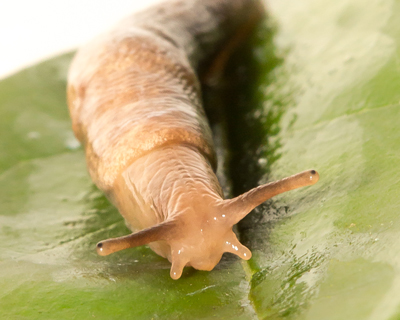10 fun facts about slugs
You’ll never look at a slug the same way again
There’s a whole lot more to slugs than munched hostas and telltale trails in the morning. To shed some light on these slippery customers, RHS entomologist Hayley Jones shares 10 slug facts that are either fascinating, gruesome or a mixture of the two – you decide!
Slug blood is blue
Slug blood is called haemolymph and is a pale blue or grey colour. While vertebrates use iron to carry oxygen in the blood, which turns red when oxygen bonds, slugs use copper, which turns blue when carrying oxygen. Rather than circulating inside blood vessels, slug haemolymph surrounds and bathes all the organs.
Slugs are right-handed
Ok, slugs don’t have hands. But they do have a ‘right-handed’ asymmetrical body – meaning their breathing pore and most of their organs are orientated to the right side of their body. Slugs evolved from snail ancestors, who are coiled inside their shells, which is why they are asymmetrical. ‘Left-handed’ slugs are incredibly rare!
The fastest slug is pretty pacey
The speediest slug is the tramp slug (Deroceras invadens), which has been recorded travelling at a breakneck speed of 17.6 metres per hour (or 29.4 centimetres per minute). Good job slugs don’t have necks either then.
These thousands of tiny teeth are arranged on a ribbon-like structure (radula), which slugs use to rasp food away, rather like an inbuilt cheese grater.
Slugs can mate with themselves
All slugs (and most snails) are hermaphrodites, meaning they have both male and female reproductive organs. When two individuals mate, both can have their eggs fertilised. Although mating is the preferred way of fertilising eggs, most slugs can also self-fertilise if necessary. Mating takes different amounts of time for different species, with some taking many hours.
Some slugs are carnivores or even cannibals
While most slugs are happy to feed on plants, algae, lichens and decaying organic matter, a few species are predatory. The ghost slug, Selenochlamys ysbryda – a white slug with no eyes that was first discovered in Wales in 2008 – hunts earthworms. (Interestingly, this seems to be the first scientific name of any organism to be based on the Welsh language.)
Shelled slugs (Testacella) feed almost exclusively on worms, but have been seen to feed on dead slugs too. The leopard slug (Limax maximus) takes this a step further – it eats fungi, lichens and dead plant material, but is also reported to eat other live slugs. Savage!
Slugs poo from their heads
Most slugs breathe and also poop from an area on the right-hand side of their mantle, which is the saddle-shaped structure on their back adjoining the head. That’s right – slugs do in fact poo from the side of their heads. (You’ve got to feel for them. Evolution, you had one job...)
The lemon slug, Melacolimax tenellus, is only found in long-established woodland. This is known as an ‘indicator species’, because its presence or abundance indicates something about the status of its ecosystem – in this case the age of the woodland.
The lemon slug feeds on fungi. Adults are only found when the woodland fungi is fruiting, and they come to the surface to feed. Juvenile lemon slugs are thought to survive in the soil, feeding on the underground fungal networks (mycelia).
-Sian-Tyrell-400x320.jpg?width=480)

